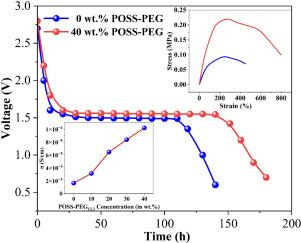Enhancing ionic conductivity, mechanical stability and electrochemical properties simultaneously by integrating POSS-PEG13.3 hybrid nanoparticles into PEO-NaClO4 solid polymer electrolytes
IF 4.3
Q2 CHEMISTRY, PHYSICAL
引用次数: 0
Abstract
The increasing global energy demand and environmental concerns necessitate the development of sustainable energy storage solutions. Sodium-ion batteries have emerged as a promising alternative to lithium-ion batteries due to the abundance and low cost of sodium. This study investigates the impact of incorporating hybrid nanoparticles, specifically polyhedral oligomeric silsesquioxane - poly(ethylene glycol) (POSS-PEG13.3), on the performance of polyethylene oxide (PEO) - sodium perchlorate (NaClO4) based solid polymer electrolytes (SPEs). The results demonstrate that the incorporation of POSS-PEG13.3 effectively disrupts the crystallinity of the PEO matrix, as confirmed by X-ray diffraction and differential scanning calorimetry analyses. Consequently, the ionic conductivity of the SPEs increases with increasing POSS-PEG13.3 content, reaching a maximum of 1.02 × 10–4 S/cm at 30 °C for the electrolyte containing 40 wt.% of POSS-PEG13.3. Furthermore, the addition of POSS-PEG13.3 significantly improves the mechanical properties of the SPEs, enhancing their stability and durability. The ionic transference number (tion = 0.988) confirm that ions are the primary charge carriers in these electrolytes. Additionally, linear sweep voltammetry and battery discharge studies indicate a wide electrochemical stability window of 3.32 V, demonstrating the suitability of these SPEs for Na-ion battery applications.

在 PEO-NaClO4 固体聚合物电解质中加入 POSS-PEG13.3 混合纳米粒子,同时提高离子导电性、机械稳定性和电化学性能
随着全球能源需求的不断增长和对环境的日益关注,有必要开发可持续的能源储存解决方案。钠离子电池由于钠元素丰富且成本低廉,已成为锂离子电池的一种有前途的替代品。本研究探讨了加入混合纳米粒子(特别是多面体低聚硅倍半氧烷-聚乙二醇(POSS-PEG13.3))对基于聚环氧乙烷(PEO)-高氯酸钠(NaClO4)的固体聚合物电解质(SPE)性能的影响。X 射线衍射和差示扫描量热分析证实,POSS-PEG13.3 的加入有效地破坏了 PEO 基体的结晶性。因此,随着 POSS-PEG13.3 含量的增加,固相萃取剂的离子电导率也随之增加,在 30 °C 时,POSS-PEG13.3 含量为 40 wt.% 的电解液的离子电导率最大可达 1.02 × 10-4 S/cm。此外,POSS-PEG13.3 的添加还显著改善了固相萃取剂的机械性能,提高了其稳定性和耐久性。离子转移数(tion = 0.988)证实离子是这些电解质中的主要电荷载体。此外,线性扫描伏安法和电池放电研究表明,电化学稳定性窗口宽达 3.32 V,证明了这些固相萃取物适用于钠离子电池应用。
本文章由计算机程序翻译,如有差异,请以英文原文为准。
求助全文
约1分钟内获得全文
求助全文
来源期刊

Chemical Physics Impact
Materials Science-Materials Science (miscellaneous)
CiteScore
2.60
自引率
0.00%
发文量
65
审稿时长
46 days
 求助内容:
求助内容: 应助结果提醒方式:
应助结果提醒方式:


